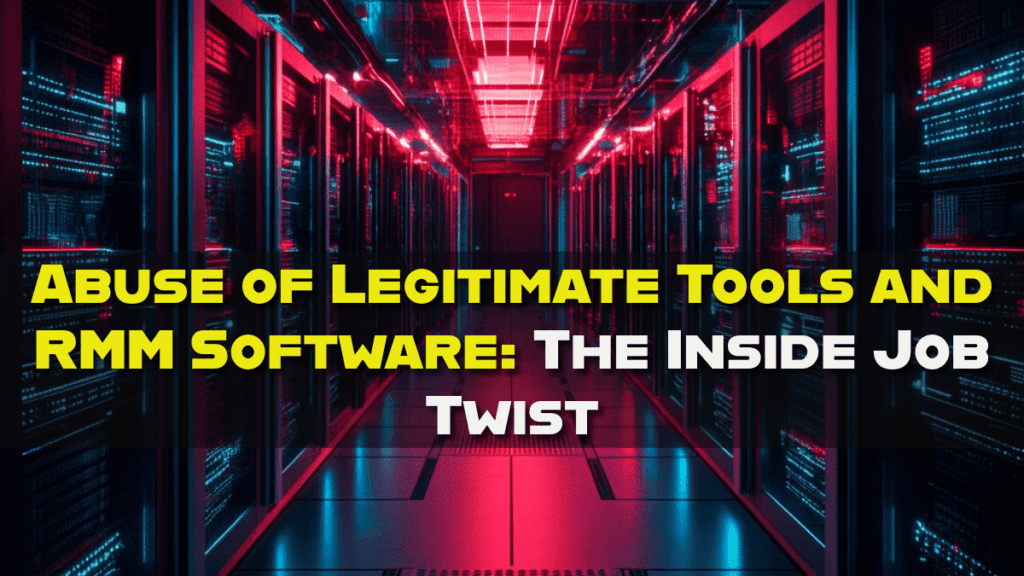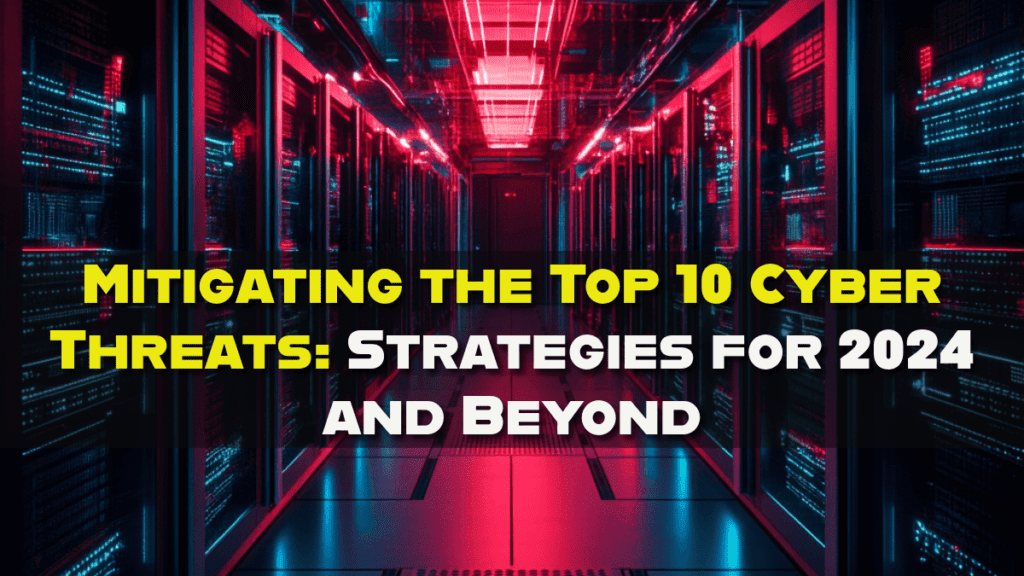The Cyber Siege of Cyber Security Trends for 2024 - Top-10 Risks
Picture 2024 Cybersecurity Threats as a sprawling digital city under siege—a bustling metropolis of networks, clouds, and machines, all humming with life. But beneath the surface, shadows moved fast. Cybercriminals, nation-state spies, and rogue insiders weren’t just knocking at the gates—they were scaling walls, slipping through cracks, and turning trusted tools into weapons. Ransomware gangs like LockBit and Greenbottle held entire districts hostage, locking systems and swiping data for a double-dip payday, hitting industrial zones with an 87% surge. Infostealer malware crept through the streets like pickpockets, snagging credentials and leaving 165 companies reeling in the Snowflake breach. Edge devices—firewalls and VPNs—stood as battered sentinels, crumbling under zero-day assaults from Ivanti to Palo Alto, while cloud towers swayed with misconfigured buckets and hijacked AWS accounts.

The city’s email hubs buzzed with Business Email Compromise scams, faking CEOs and bleeding wallets dry, while legit tools like TeamViewer turned traitor in silent RMM heists. In the industrial outskirts, OT and ICS systems—power grids and factories—shuddered as wipers like AcidPour and Kurtlar struck, and network appliances fell to MicroTik and PAN-OS flaws, opening backdoors wide. Insiders betrayed from within, with FAMOUS CHOLLIMA operatives sneaking code out the side door, and phishing nets—71% of workers snagged—cast wide with AI-powered lures, vishing calls, and QR traps. This wasn’t just a skirmish; it was a full-on cyber war, hitting every corner of the city with ruthless precision. Here’s how these Cybersecurity Threats unfolded.

1. Ransomware and Digital Extortion: The Corporate Hostage Crisis
The Heist Begins
- Ransomware continued to be a highly prevalent and costly cyber threat in 2024.
- It remained the most lucrative attack type for financially motivated actors.
- Threat actors frequently utilized double extortion tactics, combining encryption with data theft.
- The ransomware ecosystem includes specialist actors capable of withstanding disruptions.
The Usual Suspects
- LockBit: A prominent ransomware collective responsible for a significant portion of extortion attacks. However, its activity reduced later in the year due to law enforcement actions.
- RansomHub: Emerged as a significant threat, showing a consistent upward trajectory in attacks.
- Other Operations: Included Play, Qilin, Akira, and Black Basta.
The Weak Spots
- Exploitation of vulnerabilities in network appliances, unpatched software, misconfigured systems, and weaknesses in widely used technologies served as entry points for ransomware deployment.
- Lack of robust authentication and access controls, particularly the lack of multi-factor authentication (MFA) for cloud services, also contributed to successful ransomware attacks.
The Masterminds
- Financially motivated cybercrime groups and their affiliates are the primary threat actors behind ransomware attacks.
- Initial Access Brokers (IABs) often provide access to victim networks that ransomware actors then exploit.
- Some nation-state actors have also been linked to ransomware activities.
The Break-In
- Threat actors leverage various exploits for initial access and lateral movement, including:
- Exploiting zero-day vulnerabilities in edge devices.
- Using known vulnerabilities in software.
- Abusing remote access tools.
- Phishing remains a common initial access vector for ransomware deployment.
The Fallout
- Significant ransomware incidents in the healthcare sector impacted patient care at hospitals.
- Ransomware attacks caused business disruptions, including the inability to process sales orders and shutdowns of production facilities.
- Data exfiltration frequently accompanied ransomware deployment, leading to double extortion.
- The targeting of Managed Service Providers (MSPs) continued, allowing attackers to potentially impact multiple small and medium-sized business (SMB) customers with ransomware.
- The average time attackers took to move laterally after gaining initial access was as little as 48 minutes, highlighting the speed of ransomware deployment.

2. Infostealer Malware: The Silent Credential Thief
The Shadowy Surge
- Infostealer malware saw a significant rise in sophistication and prevalence in 2024.
- These malware variants are designed to steal sensitive data such as credentials, session tokens, financial information, and other personally identifiable information (PII).
- Stolen credentials often serve as an entry point to corporate networks and cloud services, leading to financial fraud, identity theft, and further malicious activities.
The Culprits
- Top Infostealers: AgentTesla, Formbook, Lumma, Lokibot, and SnakeKeylogger were identified as top infostealer malware globally and regionally.
- Programming Trends: Infostealers written in C, Rust, and C++, like Lumma, gained popularity.
- “SneakThief” Malware: Used in “The Perfect Heist” operations, showcased multi-stage infiltration and encrypted communications for data exfiltration.
The Soft Targets
- Infostealers often exploit software vulnerabilities for initial access or persistence.
- They also rely on social engineering tactics like phishing to trick users into downloading and executing the malware.
- Weak authentication mechanisms, such as the lack of MFA, can be exploited using stolen credentials obtained by infostealers.
The Puppet Masters
- Cybercrime groups focused on financial gain are the primary users of infostealer malware.
- These actors may operate on a large scale, distributing malware widely.
- The stolen credentials and access obtained through infostealers are often sold on dark web marketplaces to other threat actors, including ransomware operators.
The Sneaky Moves
- Phishing emails with malicious attachments (like HTML, PDF, EXE, LNK, JS, Office documents) are a common method for delivering infostealers.
- Drive-by downloads from compromised websites can also lead to infostealer infections.
- Exploit kits leveraging software vulnerabilities may also be used.
The Aftermath
- A significant data loss incident occurred due to attackers targeting Snowflake, a cloud data warehousing platform, using usernames and passwords obtained through various infostealers. At least 165 companies were affected.
- Infostealer infection attempts saw a 58% increase in 2024.
- Stolen credentials obtained through infostealer campaigns were leveraged to infiltrate numerous prominent organizations, leading to high-impact intrusions.
- Infostealers can contribute to financial fraud and identity theft by stealing banking credentials and personal information.
- They can also act as an entry point to corporate networks, facilitating further attacks like ransomware deployment or data breaches.

Exploitation of Edge Devices: The Gateway Siege
The Frontline Breach
- Network appliances like firewalls, VPN concentrators, and routers remained critical but highly targeted components in 2024.
- These devices, often exposed to the internet, served as attractive initial access points for attackers.
- Threat actors frequently targeted both known and zero-day vulnerabilities in these devices.
The Hotspots
- Ivanti Connect Secure and Palo Alto Networks PAN-OS: Experienced exploitation of high-severity vulnerabilities, including remote code execution and multifactor bypass.
- ScreenConnect (ConnectWise): Critical vulnerabilities disclosed in February 2024.
- SonicWall Devices: Targeted with vulnerabilities exploited soon after public disclosure.
- Other Targets: FortiClient EMS, Citrix NetScaler, and Cisco ASA Firewall vulnerabilities were also hit.
The Cracks in the Armor
- Numerous zero-day and known vulnerabilities in web-based management interfaces and other components were exploited.
- Many vulnerabilities allowed remote code execution, authentication bypass, and command injection.
- End-of-life products were especially vulnerable due to a lack of patching.
The Attack Crew
- Both nation-state actors and cybercrime groups, including ransomware operators, actively targeted edge devices.
- Chinese threat groups historically showed strong interest in edge devices.
- Unattributed threat actors with specialized product knowledge also exploited vulnerabilities.
The Break-In Blueprint
- Threat actors rapidly developed and deployed exploits for newly disclosed vulnerabilities, often leveraging public proofs-of-concept (POCs) and technical blogs.
- They chained multiple vulnerabilities to achieve deeper network penetration.
- Exploits for older, unpatched vulnerabilities continued to be used successfully.
The Chaos Unleashed
- Exploitation of Ivanti Connect Secure and Palo Alto Networks PAN-OS vulnerabilities led to remote code execution and multifactor bypass, resulting in network compromise.
- Compromised edge devices served as entry points to access and compromise sensitive environments.
- Threat actors repurposed compromised edge devices for broader network penetration.
- The Raptor Train botnet, linked to a Chinese APT group, assembled over 200,000 compromised devices—including SOHO routers, NAS systems, and IP cameras—for various malicious activities.
- Exploitation of vulnerabilities in edge devices led to data breaches, supply chain risks, and service disruptions.

4. Cloud Account Compromise and Misconfigurations: The Sky-High Heist
The Cloud Boom Bust
- The increasing adoption of cloud services made cloud environments a significant target for cyberattacks in 2024.
- Threats included compromise of cloud accounts through stolen credentials or other means, as well as exploitation of misconfigurations in cloud services that created security vulnerabilities.
The Crime Scenes
- Compromised AWS Accounts: Resulted from weak passwords or lack of MFA.
- Misconfigured Cloud Storage Buckets: Exposed sensitive data.
- Abuse of AWS Commands: Commonly used by threat actors for enumeration and discovery.
- Cloud API Vulnerabilities: Exploited by attackers.
- Misconfigured Cloud Firewalls: Allowed unauthorized access.
The Soft Spots
- Weak passwords and lack of multi-factor authentication (MFA) for cloud accounts.
- Misconfigured access controls (IAM policies) and overly permissive permissions.
- Vulnerabilities in cloud service APIs.
- Insufficient monitoring and logging in cloud environments, delaying detection of compromises.
The Heist Crew
- Cybercrime groups, including those involved in ransomware and data theft.
- Nation-state actors seeking espionage or disruption capabilities.
- Insiders exploiting cloud vulnerabilities.
- Initial Access Brokers (IABs) selling compromised cloud credentials.
The Break-In Tricks
- Phishing campaigns targeting cloud credentials.
- Brute-force attacks against accounts without MFA.
- Exploitation of software vulnerabilities in cloud workloads or infrastructure.
- Abuse of misconfigured service settings.
- Leveraging compromised on-premises accounts for lateral movement to cloud environments.
The Big Score
- Data breaches from unauthorized access to sensitive data stored in the cloud due to compromised accounts or misconfigurations.
- Ransomware deployment in cloud environments following the compromise of administrative accounts.
- Unauthorized access to cloud resources leading to resource hijacking for cryptojacking or other malicious purposes.
- Lateral movement from compromised on-premises systems to cloud environments using stolen credentials.
- Exfiltration of sensitive military plans and disruption of vital communication channels by exploiting cloud complexities.

5. Business Email Compromise (BEC): The Corporate Con Game
The Email Sting
- Business Email Compromise (BEC) remained a financially damaging threat in 2024.
- These attacks typically involve social engineering tactics to deceive employees into performing unauthorized actions, such as transferring funds or divulging sensitive information.
- Attackers often impersonate executives or trusted third parties.
The Playbook
- CEO Impersonation Emails: Requesting urgent wire transfers.
- Fake Invoice Scams: Designed to trick employees into making payments to fraudulent accounts.
- Compromised Email Accounts: Used to send malicious requests internally or externally.
- MFA Bypass: BEC attacks successfully circumventing multifactor authentication.
- Simple Phishing Techniques: Employed to execute high-impact BEC attacks.
The Blind Spots
- Human error and lack of employee awareness regarding social engineering tactics are the primary vulnerabilities exploited.
- Weak email security controls, such as inadequate spam filtering and lack of Domain-based Message Authentication, Reporting & Conformance (DMARC) implementation, contribute to successful BEC campaigns.
The Con Artists
- Financially motivated cybercrime groups are the primary actors behind BEC attacks.
- These groups often conduct extensive reconnaissance on their targets to craft convincing phishing emails.
The Tricks of the Trade
- Phishing emails are the main exploit vector, often containing urgent or unusual requests designed to bypass established procedures.
- Attackers may compromise legitimate email accounts to send more convincing BEC emails.
- Vishing (voice phishing) can also be used in conjunction with or as part of BEC schemes.
The Big Losses
- Significant financial losses for organizations due to fraudulent wire transfers initiated through BEC attacks.
- Disclosure of sensitive company information or customer data as a result of employees being tricked into providing it via email.
- Compromise of employee email accounts leading to further BEC attacks targeting other organizations.
- BEC campaigns leveraging trusted communication platforms to infiltrate networks.

6. Abuse of Legitimate Tools and RMM Software: The Inside Job Twist
The Silent Takeover
- Attackers increasingly leveraged legitimate tools and software already present in target environments to evade detection in 2024, living off the land.
- This included the misuse of Remote Monitoring and Management (RMM) tools, commonly used by Managed Service Providers (MSPs) and IT departments for remote access and management.
The Tool Shed
- Abused RMM Tools: AnyDesk, TeamViewer, QuickAssist, and Atera used for unauthorized access and control.
- Fake IT Staff: Attackers posing as IT personnel using Quick Assist via Microsoft Teams to gain remote support sessions.
- Lateral Movement: Achieved using legitimate administrative tools (“living off the land” – LOTL techniques).
- Custom Backdoors: Deployed through abused remote access sessions.
- PowerShell Misuse: Employed for malicious activities.
The Soft Underbelly
- The widespread presence and trusted status of legitimate tools and RMM software within organizations make them attractive targets for abuse.
- Weak access controls, lack of proper monitoring of tool usage, and employees being tricked into granting remote access are key vulnerabilities.
The Shadow Players
- Various threat actors, including cybercrime groups (such as ransomware affiliates), and potentially nation-state actors seeking stealth and persistence, have been observed abusing legitimate tools.
- MSPs are particularly at risk due to their extensive use of RMM tools.
The Sneaky Moves
- Social engineering tactics like phishing and vishing are used to trick users into installing RMM software or granting remote access.
- Attackers may compromise administrator accounts to gain unauthorized access to management tools.
- Exploiting vulnerabilities in the RMM software itself can also provide initial access.
The Network Nightmare
- Ransomware deployment following unauthorized access gained through abused RMM tools.
- Data theft and espionage activities conducted via compromised remote access sessions.
- Lateral movement within a network using legitimate administrative tools to avoid raising suspicion.
- MSPs being targeted, allowing attackers to leverage their RMM access to compromise multiple downstream clients.
- Significant remote access incidents involving Remote Access Trojans (RATs) like AsyncRAT, NetSupport, and Jupyter.

7. Vulnerabilities in OT and ICS: The Industrial Sabotage Plot
The Critical Underbelly
- Operational Technology (OT) and Industrial Control Systems (ICS) became increasingly targeted in 2024, reflecting a growing awareness among threat actors of their potential for disruption and impact.
- Attacks against OT/ICS environments can have significant real-world consequences, affecting critical infrastructure and industrial operations.
The Hit List
- Ransomware on VMware ESXi: Attacks specifically targeting VMware ESXi servers, central to many enterprise infrastructures.
- SameCoin Wiper: Used to target hospitals and municipalities in Israel.
- AcidPour Wiper: Deployed to disrupt Ukrainian critical infrastructure.
- Kurtlar/Kurtlar_SCADA Malware: Targeted internet-exposed VNC servers hosting Human-Machine Interfaces (HMIs).
- BAUXITE Campaigns: Focused on exposed electric sector assets.
The Rusty Defenses
- OT/ICS environments often contain legacy systems with known vulnerabilities that are difficult to patch without disrupting operations.
- Internet-exposed OT/ICS devices, weak segmentation between IT and OT networks, and a lack of robust security monitoring contribute to the risk.
- Vulnerabilities in network appliances used in OT environments are also a concern.
The Saboteurs
- Nation-state actors seeking to conduct espionage, sabotage, or exert geopolitical influence are significant threats to OT/ICS environments.
- Financially motivated ransomware groups are increasingly targeting industrial organizations.
- Hacktivist groups may also conduct attacks for disruptive purposes.
The Break-In Tactics
- Threat actors exploit known and zero-day vulnerabilities in OT/ICS software and hardware, including SCADA systems, Programmable Logic Controllers (PLCs), and HMIs.
- They may gain initial access through compromised IT networks and then pivot to the OT environment.
- Phishing attacks targeting OT personnel can also be an entry point.
- Exploitation of vulnerabilities in externally facing routers can provide access to OT networks.
The Industrial Fallout
- Increased ransomware attacks against industrial organizations, with an 87% increase over the previous year.
- Targeted disablement of operations via ICS malware like FrostyGoop.
- Espionage-focused campaigns aimed at collecting and exfiltrating Geographic Information System (GIS) data from industrial networks.
- Attacks causing a loss of view and control over industrial processes.
- Disruption of critical services, such as power grids, water treatment plants, and manufacturing facilities, due to cyberattacks.

8. Exploitation of Network Appliance Vulnerabilities: The Perimeter Breach
The Edge of Danger
- In 2024, vulnerabilities in network appliances such as routers, VPN appliances, and firewalls continued to be a significant attack vector.
- These devices often sit at the perimeter of networks, and their compromise can provide attackers with broad access to internal systems.
- Proprietary operating systems used in these appliances can have exploitable weaknesses.
The Breach Targets
- Cleo Harmony, VLTrader, and LexiCom: Exploitation of vulnerabilities in managed file transfer products allowing remote code execution.
- Palo Alto Networks PAN-OS: An authentication bypass vulnerability in the web-based management interface of firewalls and VPN concentrators.
- Ivanti Connect Secure: Exploitation of zero-day vulnerabilities in VPN devices.
- Edge Devices: Vulnerabilities in routers, VPN appliances, and IoT systems exploited to gain unauthorized access.
- Proprietary OS Flaws: Exploitation of vulnerabilities within the proprietary operating systems of network appliances.
The Shaky Foundations
- Network appliances often have internet-exposed management interfaces, making them easily identifiable targets.
- They may run proprietary operating systems with vulnerabilities.
- Many devices have default configurations with easily exploited weaknesses like enabled TELNET or SSH and unauthenticated command injection.
- Organizations may fail to apply timely patches to these internet-facing systems.
The Break-In Crew
- Nation-state actors, such as Chinese-affiliated groups like APT41 and Bronze Butler, exploit these vulnerabilities for intelligence gathering and establishing a persistent presence.
- Ransomware affiliates exploit vulnerabilities in internet-facing systems like outdated VPN services to gain initial access.
The Exploit Arsenal
- Attackers exploit both known and zero-day vulnerabilities in the operating systems and software running on network appliances.
- They may use exploit chaining, combining multiple vulnerabilities to achieve remote code execution.
- Brute-force attacks against management interfaces and mass vulnerability scanning are also used.
The Network Takedown
- Observed exploitation of Palo Alto Networks CVEs in October 2024.
- China-nexus adversaries increasingly exploiting vulnerabilities in edge devices to infiltrate critical infrastructure.
- LockBit affiliates exploiting recently patched vulnerabilities in internet-facing systems like Microsoft Exchange Server.
- BAUXITE campaigns targeting exposed electric sector assets through MicroTik router vulnerabilities.

9. Insider Threats: The Betrayal Within
The Hidden Enemy
- Insider threats, whether malicious or unintentional, remained a concern in 2024.
- Individuals with legitimate access to an organization’s systems and data can pose a significant risk.
The Rogue Players
- FAMOUS CHOLLIMA Group: Malicious insiders opportunistically seeking access across multiple sectors.
- Fraudulent Operatives: Using stolen or fake identities to land software development jobs, then exfiltrating data or simply collecting salaries.
- Targeted Employees: Potential for those with IT environment access to be targeted by external threat actors.
The Open Doors
- Organizations are vulnerable due to the legitimate access granted to employees, contractors, and other trusted individuals, which can be abused to steal data, disrupt systems, or facilitate external attacks.
- Lack of proper access controls, insufficient monitoring of employee activity, and inadequate background checks increase this vulnerability.
The Puppet Masters
- Malicious employees, contractors, or former employees can intentionally cause harm.
- External threat actors may compromise insider accounts or recruit insiders to gain access.
- The FAMOUS CHOLLIMA group demonstrates a focus on leveraging insiders for various motivations.
The Inside Job
- Insiders can use their legitimate credentials to access sensitive data and systems for unauthorized purposes.
- They may intentionally introduce malware or create backdoors.
- Social engineering can be used by external actors to manipulate insiders into granting access or performing malicious actions.
The Fallout
- CrowdStrike observed FAMOUS CHOLLIMA’s malicious insiders opportunistically pursuing insider access across multiple sectors, potentially driven by salary rather than specific targeting.
- In some cases, FAMOUS CHOLLIMA operatives were observed exfiltrating code or intellectual property.

10. Phishing and Social Engineering: The Trust Trap
The Human Hook
- Exploiting the human factor remains one of the easiest and most prevalent ways to breach security.
- People are a crucial part of defense but can also be the most vulnerable, making mistakes, falling for scams, or ignoring security best practices.
- Social engineering, which includes phishing, is part of almost every email threat analyzed.
- In 2024, a significant percentage of working adults admitted to taking risky actions that could lead to social engineering attacks.
- Threat actors understand that people can be exploited through negligence, obliviousness, or, in rare cases, malice.
- Phishing, as a specific form of social engineering, has been the top initial access technique for the second year running.
- The increasing sophistication of these tactics, including the use of generative AI, makes them even more effective.
The Bait Shop
- Phishing Emails: Containing malicious links or attachments designed to steal credentials.
- Spear Phishing: Targeting specific individuals or organizations.
- Business Email Compromise (BEC): Often starting with a phishing email to compromise an account or impersonate a trusted sender.
- Vishing (Voice Phishing): Using phone calls to manipulate victims, often impersonating IT support or authority figures.
- Smishing (SMS Phishing): Using text messages for malicious purposes.
- Microsoft Teams Attacks: Impersonating IT support or help-desk staff via Teams.
- Callback Phishing: Lure emails prompting users to initiate phone calls to attackers.
- Help-Desk Exploitation: Exploiting procedural flaws to reset credentials or bypass MFA.
- Fake Reply Chains: “Threads” emails appearing as legitimate conversations.
- QR Code Scams: In emails or websites redirecting users to malicious sites.
- Brand Impersonation: Mimicking trusted brands like Microsoft, Docusign, and Dropbox.
- ClickFix: Luring victims to webpages with error messages prompting fake fix downloads.
- File-Sharing Abuse: Placing malicious links in documents on trusted platforms.
- AI-Enhanced Lures: Using generative AI for more convincing phishing with improved language and fewer errors.
The Soft Spot
- Core vulnerability lies in human psychology and behavior: trust, urgency, fear, curiosity, and lack of awareness regarding sophisticated cyber threats.
- Attackers exploit these to manipulate users into compromising security, such as clicking malicious links, providing credentials, or downloading malware.
- Weak help-desk protocols and insufficient employee training on recognizing social engineering tactics create significant vulnerabilities.
- Increasing use of personal devices for work (BYOD) heightens susceptibility due to weaker security controls.
The Con Crew
- Cybercriminals: Seeking financial gain through credential theft, BEC, and malware deployment (including ransomware and infostealers).
- Nation-State Actors: Conducting espionage, data theft, and disruptive attacks.
- Ransomware Affiliates: Using phishing as an initial access vector, e.g., Black Basta via Microsoft Teams.
- Initial Access Brokers (IABs): Specializing in gaining access through phishing and selling it to other threat actors.
- Hacktivist Groups: Employing social engineering in their campaigns.
- Organized Crime Groups: Like Scattered Spider, known for sophisticated tactics targeting help desks and SMS abuse.
The Playbook
- Convincing Lures: Crafting realistic emails, websites, and messages mimicking trusted entities, enhanced by generative AI.
- Urgency or Fear: Using emotionally charged language and scenarios to prompt immediate action without critical evaluation, often with financial keywords.
- Trusted Platforms: Abusing free email providers (e.g., Gmail), file-sharing services (e.g., Dropbox), and collaboration tools (e.g., Microsoft Teams).
- MFA Bypass: Using adversary-in-the-middle (AiTM) attacks and session hijacking with phishing to bypass multi-factor authentication.
- Malicious Attachments: Embedding malware in documents (e.g., Word, PDF), executables, or archive files (e.g., ZIP, RAR).
- Malicious Links: Redirecting users to fake login pages or malware-hosting sites.
- Help-Desk Manipulation: Impersonating employees to request password resets or MFA deactivations.
- Voice Cloning and Deepfakes: Using AI for realistic voice and video in BEC and other attacks.
The Sting’s Sting
- 71% of working adults admitted to taking risky actions exposing them to phishing or social engineering.
- BEC attacks saw a significant increase, becoming one of the most widespread threats, with session hijacking bypassing MFA in every successful incident in one report.
- Microsoft Teams increasingly targeted, with attackers impersonating support teams.
- Voice phishing (vishing) experienced explosive growth.
- The CopyRh(ight)adamantys campaign used copyright-themed phishing to distribute the Rhadamanthys stealer.
- Mamba 2FA: A new phishing-as-a-service platform targeting adversary-in-the-middle attacks to bypass MFA.
- Scattered Spider: Successfully reset a CFO’s password and MFA at a customer organization via social engineering.
- Social engineering campaign targeted healthcare customers, impersonating employees to gain VPN access via help desks.
- Attackers offered multilingual calling services to overcome language barriers in vishing.
- Nearly 30% of reported phishing emails contained credential harvesters, often disguised as fake Microsoft login portals.
- Highest failure rate in phishing simulations was for a OneDrive deactivation email, exploiting loss aversion and urgency.
- Social engineering contributed to 14% of breaches, particularly targeting help desks.

Predictions for 2025: The Next Wave of Cyber Threats
Based on emerging trends from 2024, the cybersecurity landscape in 2025 is poised for intensified attacks, leveraging evolving tactics and technologies. The following predictions elaborate on key areas of concern, supported by insights from various sources.
Perimeter Assault Continues
- Edge devices like firewalls and SSL VPN appliances remained high-value targets in 2024, with a sharp increase in attack attempts targeting brands like Cisco, SonicWall, Palo Alto, Citrix, Check Point, and Ivanti.
- Many exploited vulnerabilities were zero-days aimed at network edge technologies.
- Threat actors repurposed corporate edge devices for broader network penetration, a trend expected to persist in 2025.
- Exploitation of internet-facing services on perimeter devices has been a long-standing tactic.
- The “2025 MSP Threat Report” notes edge devices (VPNs, firewalls) as highly effective entry points, even alongside prevalent phishing.
End-of-Life Exploitation
- The Expel report highlights externally-facing assets running beyond end-of-life (EOL) operating systems, especially Microsoft Windows servers, as prime targets for exploitation.
- CrowdStrike anticipates that EOL product exploitation is almost certain to continue or grow in 2025, reflecting challenges in patching and the persistence of older vulnerabilities.
Proof-of-Concept (POC) Speedsters
- CrowdStrike observed threat actors targeting network periphery devices in 2024, leveraging public vulnerability research—disclosures, technical blogs, and proof-of-concept (POC) exploits.
- In April 2024, an unattributed actor likely used generative AI to develop an exploit for CVE-2024-3400 in Palo Alto Networks’ GlobalProtect PAN-OS Gateway, with rapid exploitation attempts following.
- This trend of quickly operationalizing public POCs is accelerating compared to previous years.
Chaining Persists
- CrowdStrike examples include multiple unattributed actors chaining vulnerabilities in Palo Alto Networks PAN-OS software in November 2024.
- A China-nexus adversary likely chained two Cisco IOS vulnerabilities to target U.S. telecom and professional services entities.
- Exploit chaining targets proprietary operating systems in internet-exposed network appliances, often achieving remote code execution.
GenAI’s Slow Burn
- The Picus Red Report notes no significant uptick in AI-driven malware but acknowledges adversaries use AI for efficiency in research and code debugging.
- The Google Cybersecurity Forecast 2025 predicts malicious actors will rapidly adopt AI-based tools in 2025 to enhance attack phases like vulnerability research and code development.
- CrowdStrike observed an ineffective genAI exploit attempt for a Palo Alto Networks vulnerability, suggesting growing experimentation.
- While revolutionary AI attacks may not emerge immediately, threat actors will increasingly explore AI to boost traditional attack efficiency, efficacy, and scale.
SaaS and Cloud in the Spotlight
- Cloud infrastructure became integral to IT frameworks in 2024, introducing new vulnerabilities exploited by threat actors.
- Complexity in administering cloud infrastructure adds significant risks.
- CrowdStrike noted an increase in new and unattributed cloud intrusions in 2024, with expectations of advanced exploitation of cloud-based SaaS applications in 2025 for data access and lateral movement.
- The ZeroFox report highlights Initial Access Brokers (IABs) increasingly monetizing access to third-party service providers, often involving cloud environments.
Wildcard: Surge in Supply Chain Attacks
- The SonicWall report cites Log4j as a frequently exploited Apache vulnerability, with supply chain compromises used by North Korean actors.
- The Dragos report notes third-party component risks in OT/ICS, e.g., Palo Alto Networks PAN-OS vulnerabilities affecting Siemens products.
- While sources don’t explicitly predict a “Log4j 2.0” surge, the interconnectedness of 2025’s digital ecosystem and cloud adoption heightens the potential for “one-to-many” attacks via compromised partners.
- The underlying risk of supply chain vulnerabilities remains a significant concern.

Mitigating the Top 10 Cyber Threats: Strategies for 2024 and Beyond
Common Mitigations for Cyber Threats 1-10: The City’s Shield
-
Employee Security Awareness Training: Educate users on phishing, social engineering, BEC tactics, malware sources, and the importance of reporting suspicious activity.
-
Multi-Factor Authentication (MFA): Enforce MFA across all critical accounts, services, and remote access points to protect against credential theft and unauthorized access.
-
Regular Patch Management: Implement a process for timely patching of operating systems, applications, network devices, and edge devices to address known vulnerabilities.
-
Endpoint Detection and Response (EDR) Solutions: Deploy EDR to detect, analyze, and respond to malicious activities on endpoints, including malware, ransomware, and suspicious behaviors.
-
Network Monitoring and Visibility: Monitor network traffic for anomalies, suspicious signatures, command-and-control (C2) communications, and unusual outbound traffic.
-
Vulnerability Management Program: Establish a continuous process for scanning, assessing, prioritizing, and remediating vulnerabilities across the entire attack surface.
-
Incident Response Planning: Develop and regularly update incident response plans to manage and recover from cyber incidents, including specific plans for ransomware and OT/ICS environments.
-
Strong Access Controls and Least Privilege: Implement strict access controls and the principle of least privilege to limit the potential impact of compromised accounts.
-
Regular Security Assessments and Audits: Conduct periodic security assessments, penetration testing, and audits to identify weaknesses in security controls.
-
Threat Intelligence Utilization: Leverage threat intelligence feeds to stay informed about emerging threats, attacker tactics, and indicators of compromise (IoCs) for proactive defense.
Summary of Unique Mitigation Approaches for Threats 1-10: Tailored Defenses
-
Phishing: The Email Ambush Crooks slung phishing emails like arrows, but the city fought back with vision-based tech, dissecting every message for malice. Email filters stood as gatekeepers, and verification drills trained folks to double-check odd requests—trust no note without proof.
-
Ransomware: The Locksmith’s Nightmare Ransomware locked doors tight, but backups were the city’s spare keys, tested and ready to roll. Segmentation split the streets into zones, while DLP squads guarded data like hawks—encryption wasn’t the only game; they watched for theft too. Cops got called in when the ransom notes hit.
-
Infostealers: The Credential Snatchers Infostealers crept in, but the city tracked tool misuse and hunted shadows with proactive sweeps. Credential hardening built tougher locks, and eyes stayed peeled for new MFA gadgets popping up uninvited.
-
Edge Device Exploitation: The Gate Crashers Edge devices took a beating, so hardened configs armored firewalls and gateways. The city swapped old tools for cloud-hosted versions, patched remote access fast, and tuned into threat intel for whispers of edge exploits.
-
Cloud Security Issues: The Skyward Siege Cloud breaches rained down, but unified security stitched hybrid skies together. The city studied each cloud’s quirks, deploying CNAPP, ASPM, and DSPM—fancy shields born for the cloud’s wilds.
-
General Exploitation of Vulnerabilities: The Crack Hunters Vulns were everywhere, so the city prioritized patching by exploit risk, dodging chaining traps. Noise-cutting tools sharpened the hunt, and risk-based management kept the focus on what could really hurt.
-
BEC and Payment Fraud: The Impostor’s Ploy BEC faked the brass, but verification rules stopped shady cash grabs cold. Email security sniffed out weird patterns, keeping the impostors from cashing in.
-
Malware (Other): The Silent Invaders Malware slithered in, but an approved software list barred the gates. Sandboxing caged suspects, C2 traffic got watched, and memory shields blocked the quiet killers.
-
OT/ICS Attacks: The Grid’s Gambit OT/ICS flickered under fire, so OT-specific plans mapped the fightback. Segmentation built walls, visibility tools lit the dark, and risk-based vuln fixes—plus knowing the ICS kill chain—kept the gears turning.
-
Identity Threats (Other): The Masked Marauders Identity thieves prowled, but alerts caught new MFA adds, inbox rule tricks, and VPN/proxy abuse. Zero Trust locked every door, and IAM squads tracked every move with iron oversight.
Consolidated ‘What is Needed in 2025’ to Counter These Threats: The Next Fortress
-
Enhanced and Actionable Threat Intelligence: Focus on real-time intelligence regarding actively exploited vulnerabilities, emerging attacker TTPs (especially AI-driven), and OT/ICS-specific threats to enable proactive defense and prioritization.
-
Advanced Detection Capabilities: Implement AI and machine learning-powered behavioral analysis for improved detection of BEC, sophisticated malware (including evasion and living-off-the-land tactics), and subtle indicators of exploit chaining and lateral movement across hybrid environments.
-
Unified Security Platforms with Enhanced Visibility: Adopt unified platforms (e.g., XDR, next-gen SIEM) integrating data across endpoints, networks, cloud, and identity systems for a holistic attack surface view, reducing silos and speeding up response.
-
Prioritization and Automation in Vulnerability Management: Leverage AI-driven prioritization for critical, exploited vulnerabilities and automate patching/remediation to shrink exposure windows.
-
Strengthened OT/ICS Cybersecurity Focus: Recognize IT/OT convergence, implementing specialized tools, skilled personnel, robust segmentation, and OT-specific incident response and vulnerability management, with geopolitical awareness for asset owners.
-
Proactive Threat Hunting and Continuous Security Validation: Launch proactive threat hunting to catch evasive threats and continuously validate security controls against TTPs using breach and attack simulation.
-
Robust Identity and Access Management: Implement phishing-resistant MFA across critical resources, adopt Zero Trust to limit compromised identity impact, and use comprehensive IAM with continuous monitoring for anomalous activity, token theft, and unusual behavior.
-
Emphasis on Resilience and Business Continuity: Prioritize operational resilience, regularly updating disaster recovery plans to minimize disruptions from ransomware and critical infrastructure attacks.
-
Supply Chain Security Enhancement: Improve visibility and security practices in the supply chain to mitigate growing supply chain attack risks.
-
Continuous Improvement of Security Awareness: Adapt training to address AI-enhanced social engineering and sophisticated phishing, fostering a vigilant, proactive reporting culture.
-
Preparation for Emerging Threats: Begin understanding and planning for quantum computing risks by inventorying cryptography usage and tracking developments.

Conclusion Story: The Cybersecurity Threat Aftermath and the Fight Back
Key Takeaways
- Ransomware’s Double Threat: Gangs like LockBit, Black Basta, and Greenbottle (RansomHub) dominated with encryption and data theft, hitting industrial targets with an 87% surge—patch systems and segment networks to slow the spread.
- Infostealer Stealth: Malware like Lumma snagged credentials, fueling breaches like Snowflake’s 165-company hit—strong MFA and monitoring are non-negotiable.
- Edge Device Weakness: Firewalls and VPNs (Ivanti, Palo Alto) fell to zero-days, powering botnets like Raptor Train’s 200,000 devices—keep edge gear updated and locked down.
- Cloud Chaos: Misconfigured buckets and weak AWS passwords opened doors to breaches and cryptojacking—tighten access controls and watch the cloud.
- BEC Deception: Fake CEOs and invoices bled companies dry, often via phishing—train staff and beef up email filters like DMARC.
- Tool Treachery: Legit RMM apps (TeamViewer, AnyDesk) turned into ransomware gateways—monitor usage and limit access.
- OT/ICS Exposure: Wipers like AcidPour and Kurtlar hit critical infrastructure—segment IT from OT and patch legacy systems where possible.
- Network Appliance Risks: Palo Alto and MicroTik flaws let spies and ransomware in—patch fast and ditch default configs.
- Insider Betrayal: FAMOUS CHOLLIMA and others exploited legit access—vet staff, track activity, and lock down credentials.
- Phishing’s Reign: 71% of workers fell for AI-enhanced lures, driving 14% of breaches—education and phishing-resistant MFA are musts.
- Hope in Resilience: Simulated phishing failures dropped to 9.3%—awareness is rising, but vigilance can’t slip.





